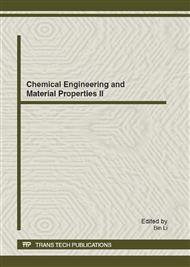p.172
p.177
p.183
p.188
p.193
p.198
p.203
p.207
p.212
Structure and Thermo-Chemical Stability of Sr-Fe-Co-O Mixed Metal Oxides
Abstract:
SrFexCo0.5Oδ (x=0.5, 0.75, 1.0, 1.25) mixed metal oxides were synthesized by the citrate method. The structure and thermo-chemical stability of the obtained SrFexCo0.5Oδ powders were investigated by X-ray diffraction (XRD) and scanning electron microscopy (SEM). XRD results show that the SrFexCo0.5Oδ powders are composed of perovskite-type cubic structure at both room temperature and high temperature. The crystalline phases of the SrFexCo0.5Oδ powders are dependent on the content of Fe and SrFe0.5Co0.5O3, SrFe0.19Co081O2.78 are the main crystalline phases. The powders have good thermo-chemical stability at elevated temperatures in helium, which is confirmed by an in-situ high-temperature X-ray diffraction. The SEM images show that the product of the SrFexCo0.5Oδ (x=0.5, 1.0) is composed of single grain, while other two samples consist of layer structures and some open porosities.
Info:
Periodical:
Pages:
193-197
Citation:
Online since:
July 2012
Authors:
Price:
Сopyright:
© 2012 Trans Tech Publications Ltd. All Rights Reserved
Share:
Citation:


